Financial Instruments: Asset Valuation for Hertfordshire Petroleum plc
VerifiedAdded on 2022/08/29
|8
|1410
|21
Report
AI Summary
This report provides a comprehensive overview of asset valuation and the application of derivative instruments for financial risk management, specifically tailored for Hertfordshire Petroleum plc. It begins by detailing the principles of futures and forwards, including pricing and valuation concepts such as cost of carry, contango, and backwardation, while highlighting the differences between futures and forwards. The report then delves into option valuation, explaining key models like the Binomial Tree and Black-Scholes Merton model, along with the determinants of option value. It discusses the pros and cons of using options for the company. Finally, the report covers the valuation of swaps and bonds with embedded options. The analysis is designed to help new staff members understand and utilize these instruments effectively within the context of the company's operations.
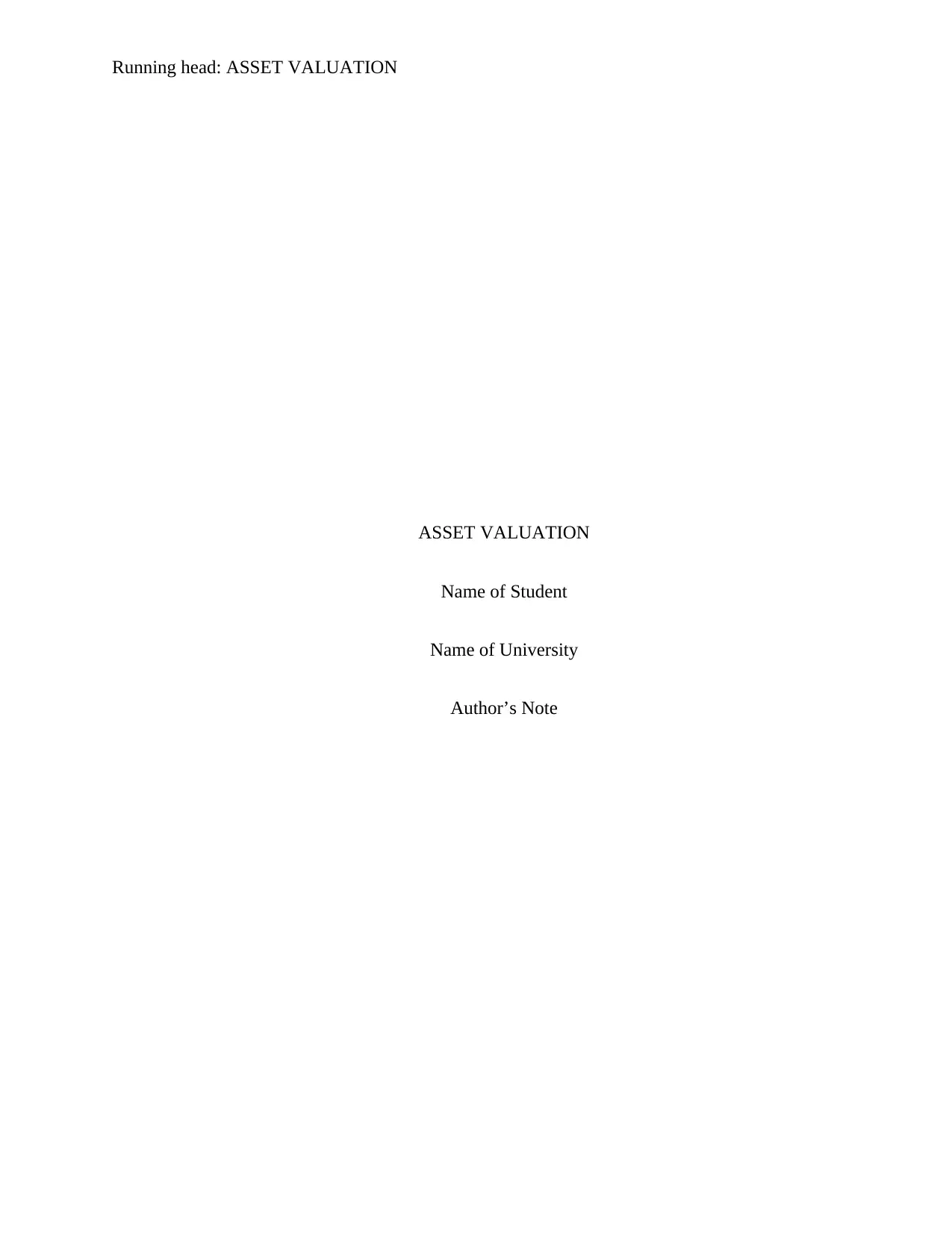
Running head: ASSET VALUATION
ASSET VALUATION
Name of Student
Name of University
Author’s Note
ASSET VALUATION
Name of Student
Name of University
Author’s Note
Paraphrase This Document
Need a fresh take? Get an instant paraphrase of this document with our AI Paraphraser
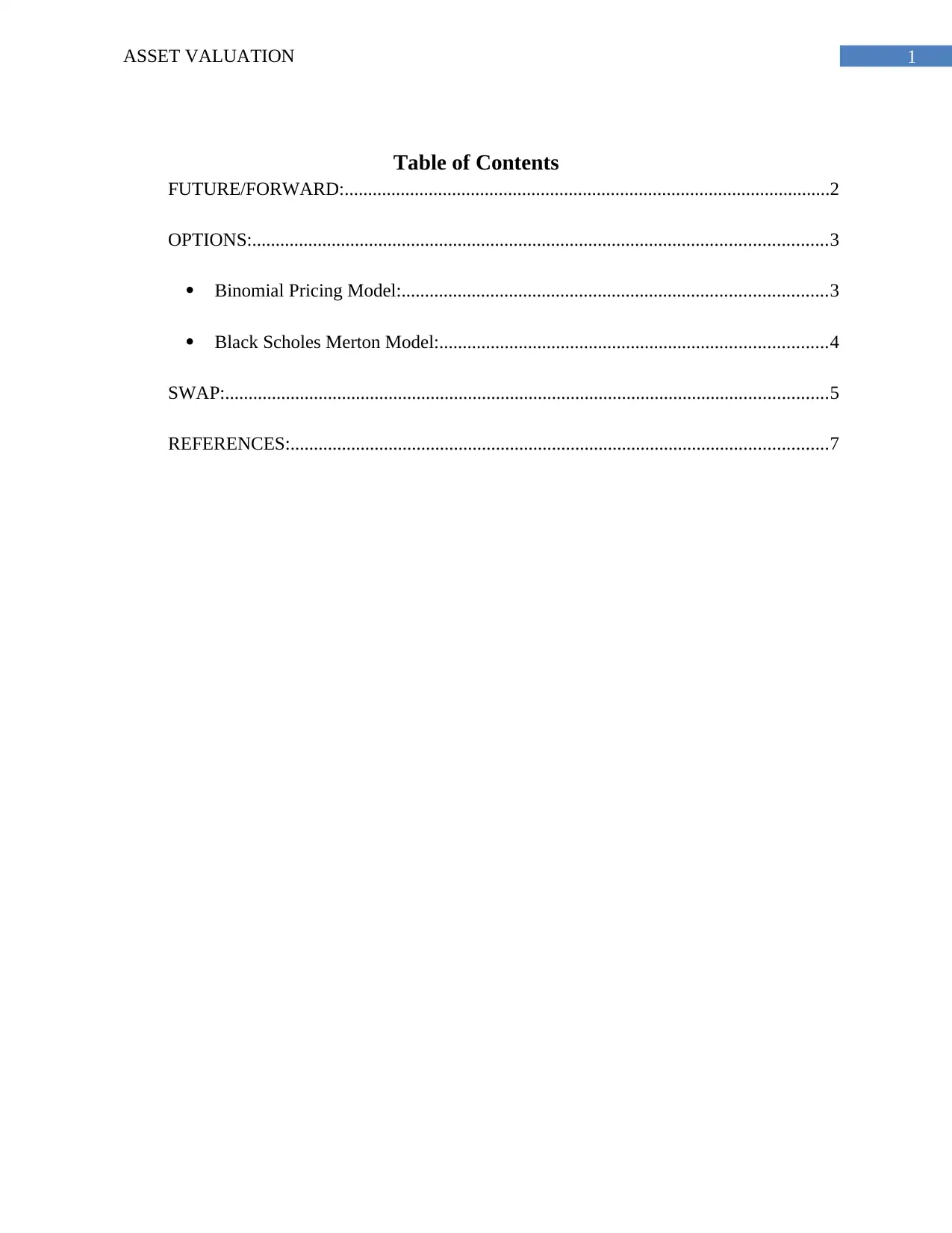
1ASSET VALUATION
Table of Contents
FUTURE/FORWARD:........................................................................................................2
OPTIONS:...........................................................................................................................3
Binomial Pricing Model:...........................................................................................3
Black Scholes Merton Model:...................................................................................4
SWAP:.................................................................................................................................5
REFERENCES:...................................................................................................................7
Table of Contents
FUTURE/FORWARD:........................................................................................................2
OPTIONS:...........................................................................................................................3
Binomial Pricing Model:...........................................................................................3
Black Scholes Merton Model:...................................................................................4
SWAP:.................................................................................................................................5
REFERENCES:...................................................................................................................7
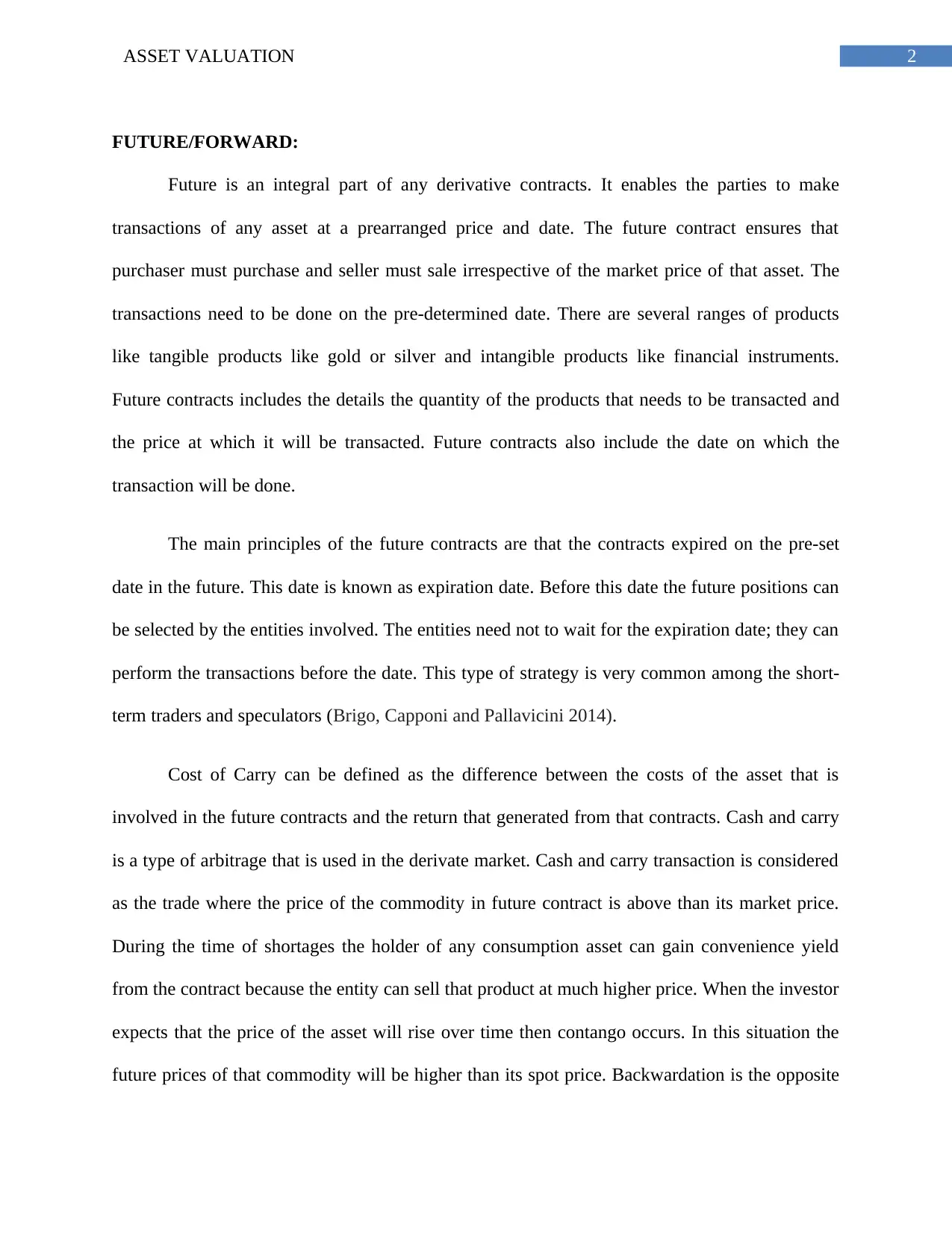
2ASSET VALUATION
FUTURE/FORWARD:
Future is an integral part of any derivative contracts. It enables the parties to make
transactions of any asset at a prearranged price and date. The future contract ensures that
purchaser must purchase and seller must sale irrespective of the market price of that asset. The
transactions need to be done on the pre-determined date. There are several ranges of products
like tangible products like gold or silver and intangible products like financial instruments.
Future contracts includes the details the quantity of the products that needs to be transacted and
the price at which it will be transacted. Future contracts also include the date on which the
transaction will be done.
The main principles of the future contracts are that the contracts expired on the pre-set
date in the future. This date is known as expiration date. Before this date the future positions can
be selected by the entities involved. The entities need not to wait for the expiration date; they can
perform the transactions before the date. This type of strategy is very common among the short-
term traders and speculators (Brigo, Capponi and Pallavicini 2014).
Cost of Carry can be defined as the difference between the costs of the asset that is
involved in the future contracts and the return that generated from that contracts. Cash and carry
is a type of arbitrage that is used in the derivate market. Cash and carry transaction is considered
as the trade where the price of the commodity in future contract is above than its market price.
During the time of shortages the holder of any consumption asset can gain convenience yield
from the contract because the entity can sell that product at much higher price. When the investor
expects that the price of the asset will rise over time then contango occurs. In this situation the
future prices of that commodity will be higher than its spot price. Backwardation is the opposite
FUTURE/FORWARD:
Future is an integral part of any derivative contracts. It enables the parties to make
transactions of any asset at a prearranged price and date. The future contract ensures that
purchaser must purchase and seller must sale irrespective of the market price of that asset. The
transactions need to be done on the pre-determined date. There are several ranges of products
like tangible products like gold or silver and intangible products like financial instruments.
Future contracts includes the details the quantity of the products that needs to be transacted and
the price at which it will be transacted. Future contracts also include the date on which the
transaction will be done.
The main principles of the future contracts are that the contracts expired on the pre-set
date in the future. This date is known as expiration date. Before this date the future positions can
be selected by the entities involved. The entities need not to wait for the expiration date; they can
perform the transactions before the date. This type of strategy is very common among the short-
term traders and speculators (Brigo, Capponi and Pallavicini 2014).
Cost of Carry can be defined as the difference between the costs of the asset that is
involved in the future contracts and the return that generated from that contracts. Cash and carry
is a type of arbitrage that is used in the derivate market. Cash and carry transaction is considered
as the trade where the price of the commodity in future contract is above than its market price.
During the time of shortages the holder of any consumption asset can gain convenience yield
from the contract because the entity can sell that product at much higher price. When the investor
expects that the price of the asset will rise over time then contango occurs. In this situation the
future prices of that commodity will be higher than its spot price. Backwardation is the opposite
⊘ This is a preview!⊘
Do you want full access?
Subscribe today to unlock all pages.

Trusted by 1+ million students worldwide
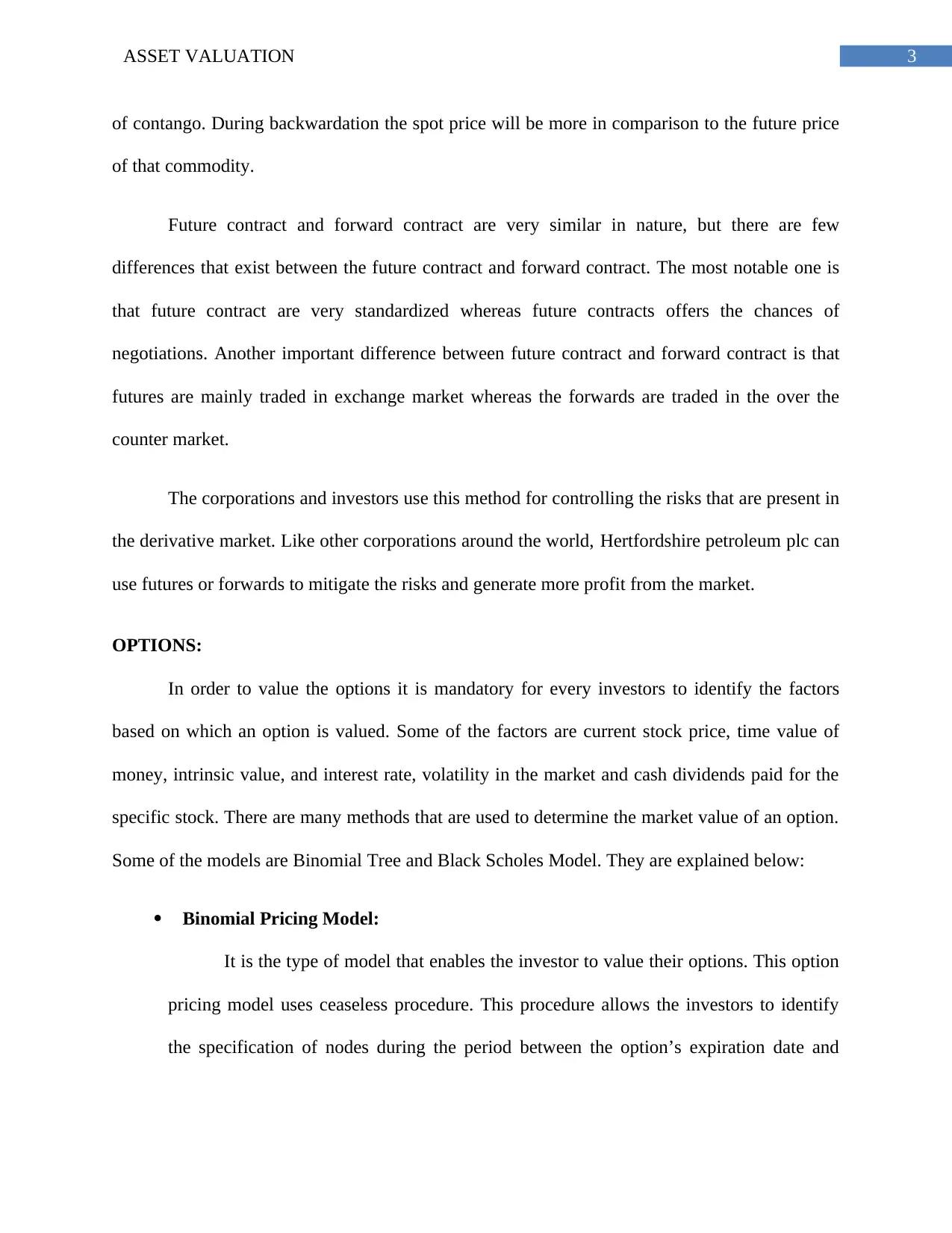
3ASSET VALUATION
of contango. During backwardation the spot price will be more in comparison to the future price
of that commodity.
Future contract and forward contract are very similar in nature, but there are few
differences that exist between the future contract and forward contract. The most notable one is
that future contract are very standardized whereas future contracts offers the chances of
negotiations. Another important difference between future contract and forward contract is that
futures are mainly traded in exchange market whereas the forwards are traded in the over the
counter market.
The corporations and investors use this method for controlling the risks that are present in
the derivative market. Like other corporations around the world, Hertfordshire petroleum plc can
use futures or forwards to mitigate the risks and generate more profit from the market.
OPTIONS:
In order to value the options it is mandatory for every investors to identify the factors
based on which an option is valued. Some of the factors are current stock price, time value of
money, intrinsic value, and interest rate, volatility in the market and cash dividends paid for the
specific stock. There are many methods that are used to determine the market value of an option.
Some of the models are Binomial Tree and Black Scholes Model. They are explained below:
Binomial Pricing Model:
It is the type of model that enables the investor to value their options. This option
pricing model uses ceaseless procedure. This procedure allows the investors to identify
the specification of nodes during the period between the option’s expiration date and
of contango. During backwardation the spot price will be more in comparison to the future price
of that commodity.
Future contract and forward contract are very similar in nature, but there are few
differences that exist between the future contract and forward contract. The most notable one is
that future contract are very standardized whereas future contracts offers the chances of
negotiations. Another important difference between future contract and forward contract is that
futures are mainly traded in exchange market whereas the forwards are traded in the over the
counter market.
The corporations and investors use this method for controlling the risks that are present in
the derivative market. Like other corporations around the world, Hertfordshire petroleum plc can
use futures or forwards to mitigate the risks and generate more profit from the market.
OPTIONS:
In order to value the options it is mandatory for every investors to identify the factors
based on which an option is valued. Some of the factors are current stock price, time value of
money, intrinsic value, and interest rate, volatility in the market and cash dividends paid for the
specific stock. There are many methods that are used to determine the market value of an option.
Some of the models are Binomial Tree and Black Scholes Model. They are explained below:
Binomial Pricing Model:
It is the type of model that enables the investor to value their options. This option
pricing model uses ceaseless procedure. This procedure allows the investors to identify
the specification of nodes during the period between the option’s expiration date and
Paraphrase This Document
Need a fresh take? Get an instant paraphrase of this document with our AI Paraphraser
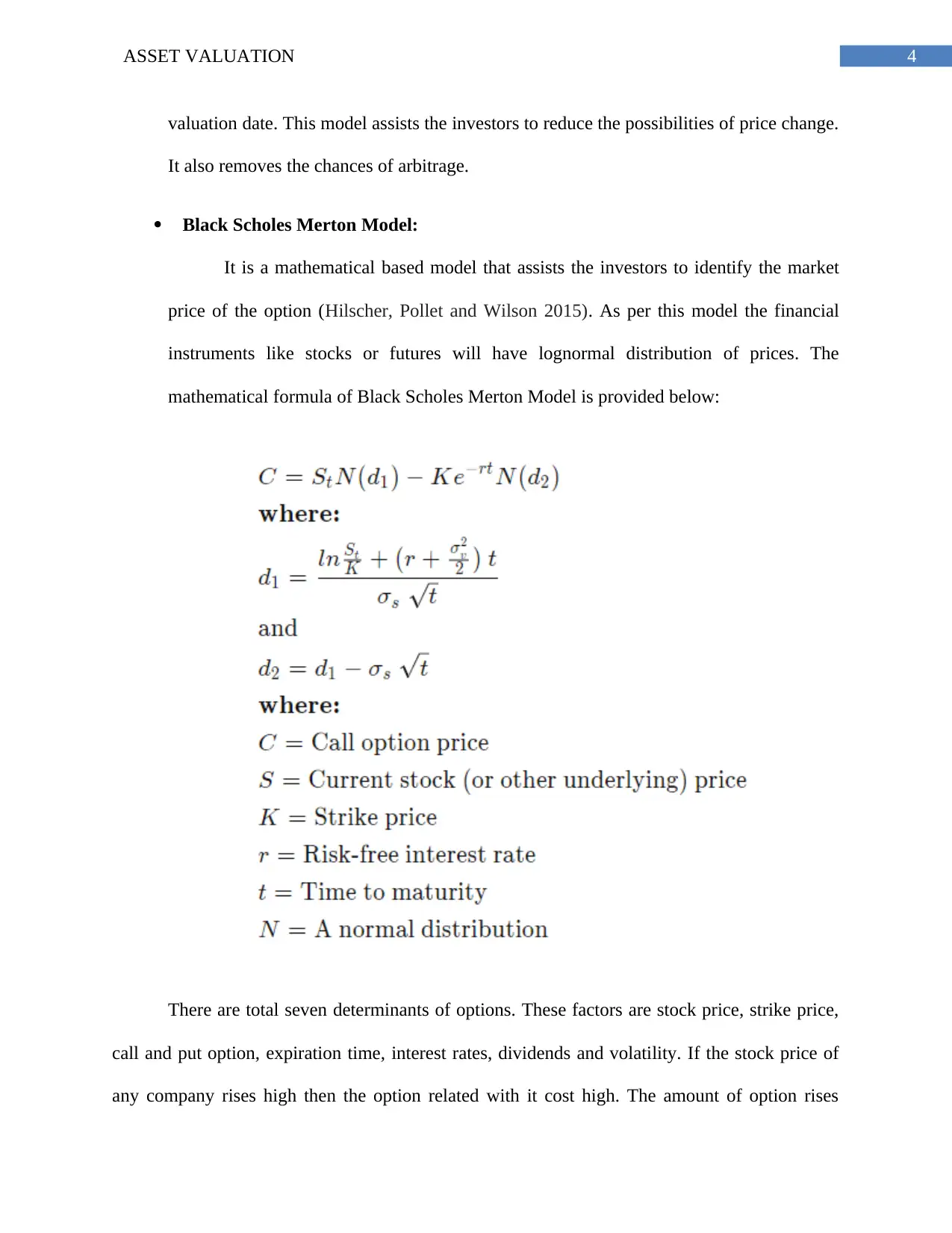
4ASSET VALUATION
valuation date. This model assists the investors to reduce the possibilities of price change.
It also removes the chances of arbitrage.
Black Scholes Merton Model:
It is a mathematical based model that assists the investors to identify the market
price of the option (Hilscher, Pollet and Wilson 2015). As per this model the financial
instruments like stocks or futures will have lognormal distribution of prices. The
mathematical formula of Black Scholes Merton Model is provided below:
There are total seven determinants of options. These factors are stock price, strike price,
call and put option, expiration time, interest rates, dividends and volatility. If the stock price of
any company rises high then the option related with it cost high. The amount of option rises
valuation date. This model assists the investors to reduce the possibilities of price change.
It also removes the chances of arbitrage.
Black Scholes Merton Model:
It is a mathematical based model that assists the investors to identify the market
price of the option (Hilscher, Pollet and Wilson 2015). As per this model the financial
instruments like stocks or futures will have lognormal distribution of prices. The
mathematical formula of Black Scholes Merton Model is provided below:
There are total seven determinants of options. These factors are stock price, strike price,
call and put option, expiration time, interest rates, dividends and volatility. If the stock price of
any company rises high then the option related with it cost high. The amount of option rises
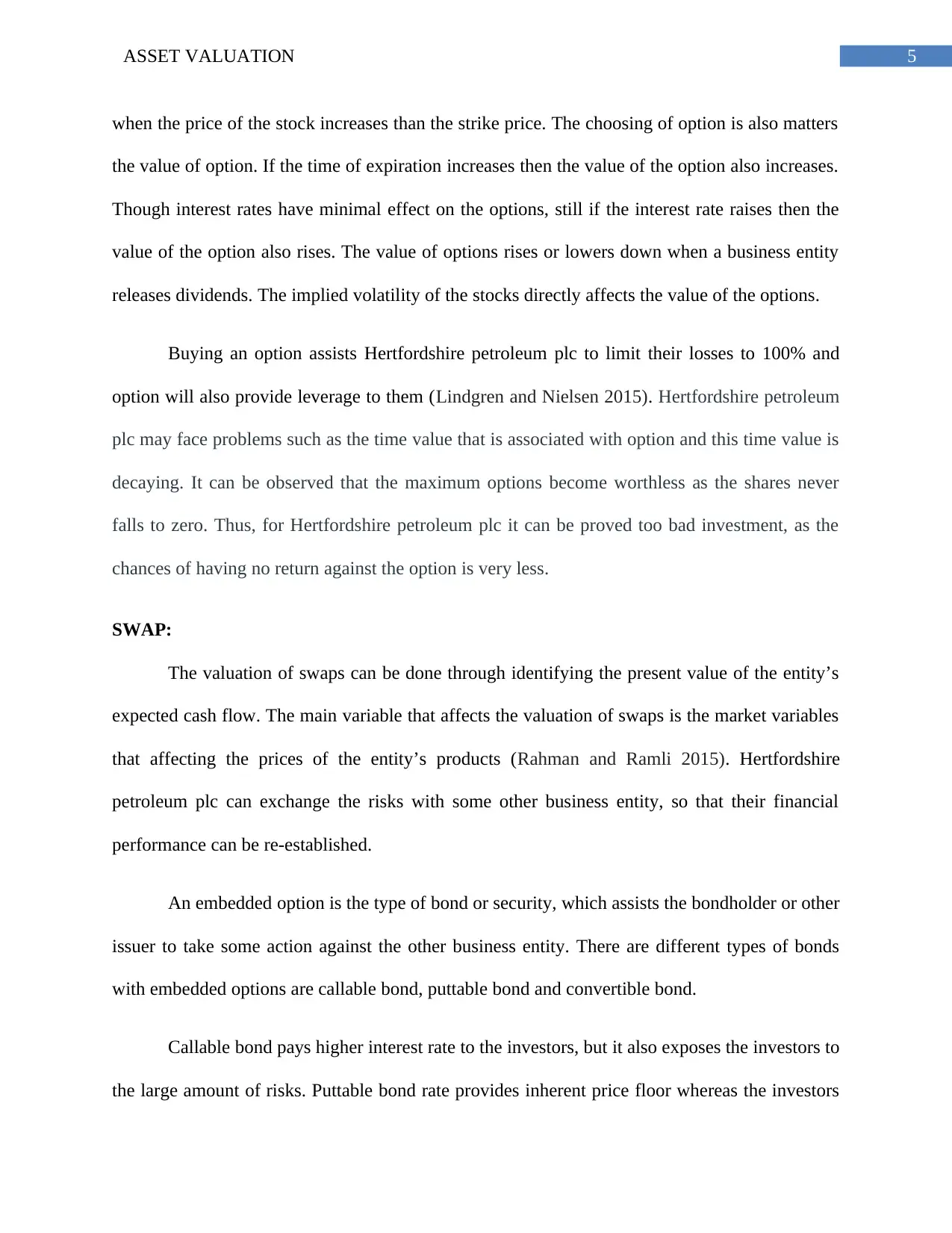
5ASSET VALUATION
when the price of the stock increases than the strike price. The choosing of option is also matters
the value of option. If the time of expiration increases then the value of the option also increases.
Though interest rates have minimal effect on the options, still if the interest rate raises then the
value of the option also rises. The value of options rises or lowers down when a business entity
releases dividends. The implied volatility of the stocks directly affects the value of the options.
Buying an option assists Hertfordshire petroleum plc to limit their losses to 100% and
option will also provide leverage to them (Lindgren and Nielsen 2015). Hertfordshire petroleum
plc may face problems such as the time value that is associated with option and this time value is
decaying. It can be observed that the maximum options become worthless as the shares never
falls to zero. Thus, for Hertfordshire petroleum plc it can be proved too bad investment, as the
chances of having no return against the option is very less.
SWAP:
The valuation of swaps can be done through identifying the present value of the entity’s
expected cash flow. The main variable that affects the valuation of swaps is the market variables
that affecting the prices of the entity’s products (Rahman and Ramli 2015). Hertfordshire
petroleum plc can exchange the risks with some other business entity, so that their financial
performance can be re-established.
An embedded option is the type of bond or security, which assists the bondholder or other
issuer to take some action against the other business entity. There are different types of bonds
with embedded options are callable bond, puttable bond and convertible bond.
Callable bond pays higher interest rate to the investors, but it also exposes the investors to
the large amount of risks. Puttable bond rate provides inherent price floor whereas the investors
when the price of the stock increases than the strike price. The choosing of option is also matters
the value of option. If the time of expiration increases then the value of the option also increases.
Though interest rates have minimal effect on the options, still if the interest rate raises then the
value of the option also rises. The value of options rises or lowers down when a business entity
releases dividends. The implied volatility of the stocks directly affects the value of the options.
Buying an option assists Hertfordshire petroleum plc to limit their losses to 100% and
option will also provide leverage to them (Lindgren and Nielsen 2015). Hertfordshire petroleum
plc may face problems such as the time value that is associated with option and this time value is
decaying. It can be observed that the maximum options become worthless as the shares never
falls to zero. Thus, for Hertfordshire petroleum plc it can be proved too bad investment, as the
chances of having no return against the option is very less.
SWAP:
The valuation of swaps can be done through identifying the present value of the entity’s
expected cash flow. The main variable that affects the valuation of swaps is the market variables
that affecting the prices of the entity’s products (Rahman and Ramli 2015). Hertfordshire
petroleum plc can exchange the risks with some other business entity, so that their financial
performance can be re-established.
An embedded option is the type of bond or security, which assists the bondholder or other
issuer to take some action against the other business entity. There are different types of bonds
with embedded options are callable bond, puttable bond and convertible bond.
Callable bond pays higher interest rate to the investors, but it also exposes the investors to
the large amount of risks. Puttable bond rate provides inherent price floor whereas the investors
⊘ This is a preview!⊘
Do you want full access?
Subscribe today to unlock all pages.

Trusted by 1+ million students worldwide
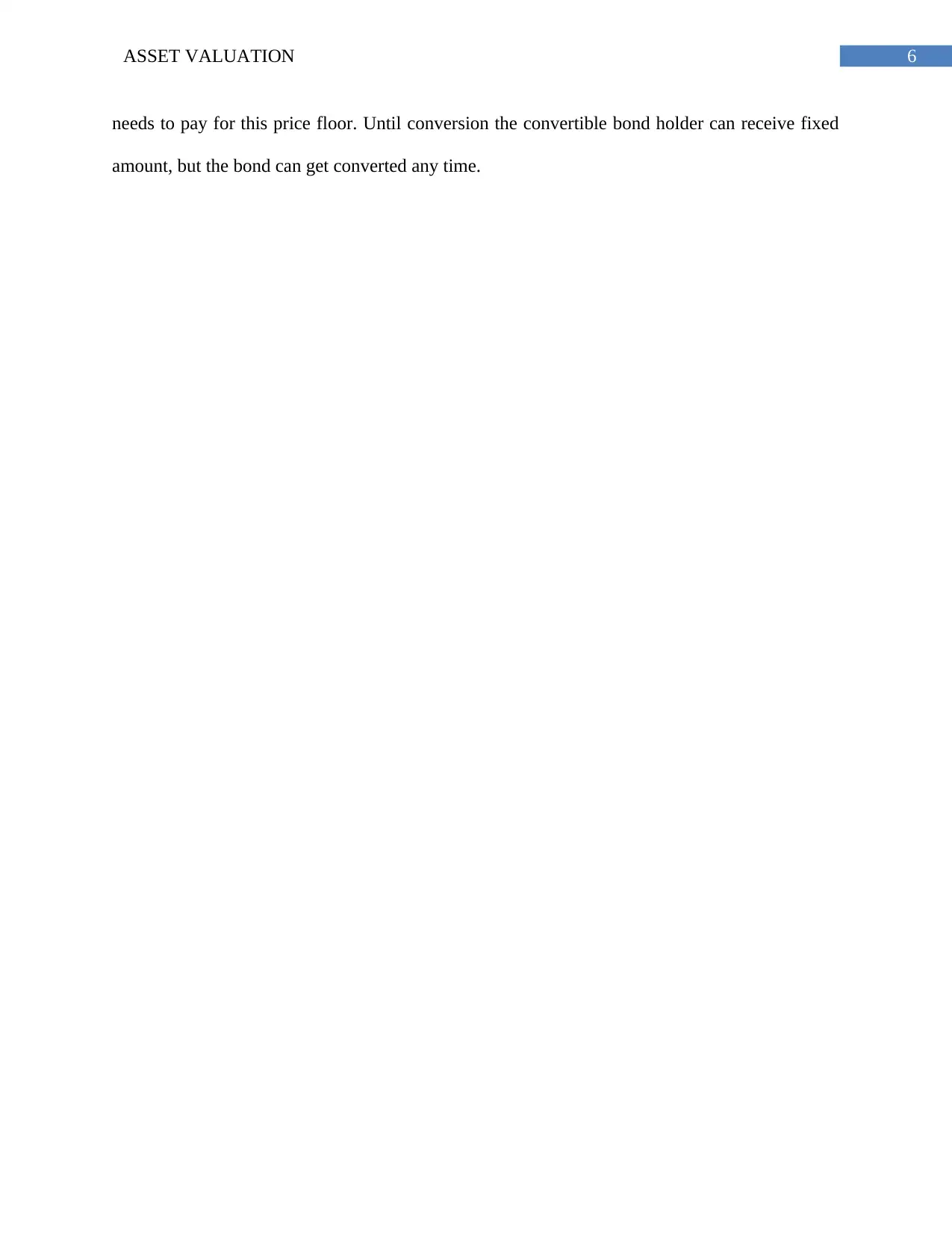
6ASSET VALUATION
needs to pay for this price floor. Until conversion the convertible bond holder can receive fixed
amount, but the bond can get converted any time.
needs to pay for this price floor. Until conversion the convertible bond holder can receive fixed
amount, but the bond can get converted any time.
Paraphrase This Document
Need a fresh take? Get an instant paraphrase of this document with our AI Paraphraser
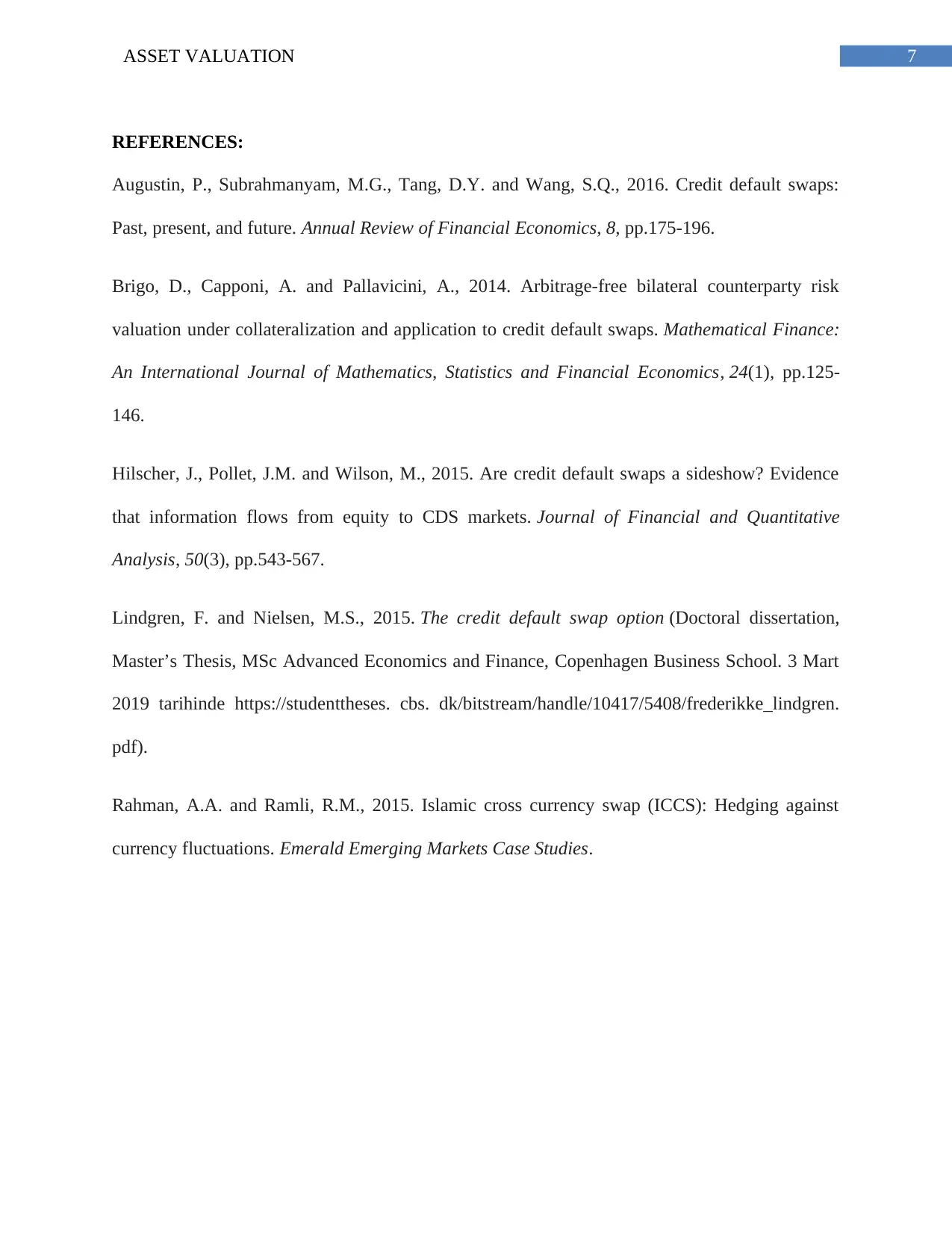
7ASSET VALUATION
REFERENCES:
Augustin, P., Subrahmanyam, M.G., Tang, D.Y. and Wang, S.Q., 2016. Credit default swaps:
Past, present, and future. Annual Review of Financial Economics, 8, pp.175-196.
Brigo, D., Capponi, A. and Pallavicini, A., 2014. Arbitrage‐free bilateral counterparty risk
valuation under collateralization and application to credit default swaps. Mathematical Finance:
An International Journal of Mathematics, Statistics and Financial Economics, 24(1), pp.125-
146.
Hilscher, J., Pollet, J.M. and Wilson, M., 2015. Are credit default swaps a sideshow? Evidence
that information flows from equity to CDS markets. Journal of Financial and Quantitative
Analysis, 50(3), pp.543-567.
Lindgren, F. and Nielsen, M.S., 2015. The credit default swap option (Doctoral dissertation,
Master’s Thesis, MSc Advanced Economics and Finance, Copenhagen Business School. 3 Mart
2019 tarihinde https://studenttheses. cbs. dk/bitstream/handle/10417/5408/frederikke_lindgren.
pdf).
Rahman, A.A. and Ramli, R.M., 2015. Islamic cross currency swap (ICCS): Hedging against
currency fluctuations. Emerald Emerging Markets Case Studies.
REFERENCES:
Augustin, P., Subrahmanyam, M.G., Tang, D.Y. and Wang, S.Q., 2016. Credit default swaps:
Past, present, and future. Annual Review of Financial Economics, 8, pp.175-196.
Brigo, D., Capponi, A. and Pallavicini, A., 2014. Arbitrage‐free bilateral counterparty risk
valuation under collateralization and application to credit default swaps. Mathematical Finance:
An International Journal of Mathematics, Statistics and Financial Economics, 24(1), pp.125-
146.
Hilscher, J., Pollet, J.M. and Wilson, M., 2015. Are credit default swaps a sideshow? Evidence
that information flows from equity to CDS markets. Journal of Financial and Quantitative
Analysis, 50(3), pp.543-567.
Lindgren, F. and Nielsen, M.S., 2015. The credit default swap option (Doctoral dissertation,
Master’s Thesis, MSc Advanced Economics and Finance, Copenhagen Business School. 3 Mart
2019 tarihinde https://studenttheses. cbs. dk/bitstream/handle/10417/5408/frederikke_lindgren.
pdf).
Rahman, A.A. and Ramli, R.M., 2015. Islamic cross currency swap (ICCS): Hedging against
currency fluctuations. Emerald Emerging Markets Case Studies.
1 out of 8
Related Documents
Your All-in-One AI-Powered Toolkit for Academic Success.
+13062052269
info@desklib.com
Available 24*7 on WhatsApp / Email
![[object Object]](/_next/static/media/star-bottom.7253800d.svg)
Unlock your academic potential
Copyright © 2020–2025 A2Z Services. All Rights Reserved. Developed and managed by ZUCOL.





